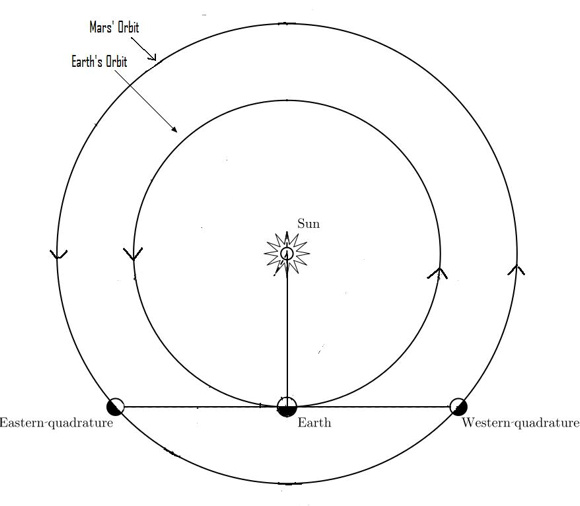Mars reaches western quadrature on March 24, 2018. At this time, it’s 90 degrees west of the sun, as seen from Earth.
Look at the charts above and below. Both are bird’s-eye views of our solar system. The chart above (via Fourmilab) shows Earth (blue) and Mars (red) on March 24.
The chart below is another view of Mars at quadrature. As seen from earthly north, Earth and Mars orbit the sun counterclockwise and spin around their rotational axes counterclockwise. When Mars is at quadrature, the sun-Earth-Mars make a right angle in space, with Earth residing at the vertex of this angle.
Earth is an inferior planet as seen from Mars; that is, it orbits inside Mars’ orbit around the sun. When Mars is at western quadrature in Earth’s sky, Earth is at or near a greatest elongation – greatest distance from the sun on the sky’s dome – as seen from Mars.
Want to see Mars in your sky? Click here.

East and west quadrature of Mars.
Unlike the moon at western quadrature, which appears 50% illuminated, any superior planet – planet orbiting the sun outside Earth’s orbit – at western quadrature always displays a nearly full phase.
On March 24, Mars will be a little over 88% illuminated at western quadrature. But because Mars’ orbit is quite eccentric (oblong) rather than perfectly circular, its minimal phase will occur about 3 weeks after Mars’ March 24 western quadrature. The phase won’t decrease by much, though, as the red planet will be only slightly less than 88% illuminated around mid-April 2018.
Click here to find out Mars’ present phase, remembering to choose Mars as your object of interest.
Geocentric Ephemeris for Mars: 2018
Bottom line: Mars reaches western quadrature on March 24, 2018.
from EarthSky https://ift.tt/2pzeZoe
Mars reaches western quadrature on March 24, 2018. At this time, it’s 90 degrees west of the sun, as seen from Earth.
Look at the charts above and below. Both are bird’s-eye views of our solar system. The chart above (via Fourmilab) shows Earth (blue) and Mars (red) on March 24.
The chart below is another view of Mars at quadrature. As seen from earthly north, Earth and Mars orbit the sun counterclockwise and spin around their rotational axes counterclockwise. When Mars is at quadrature, the sun-Earth-Mars make a right angle in space, with Earth residing at the vertex of this angle.
Earth is an inferior planet as seen from Mars; that is, it orbits inside Mars’ orbit around the sun. When Mars is at western quadrature in Earth’s sky, Earth is at or near a greatest elongation – greatest distance from the sun on the sky’s dome – as seen from Mars.
Want to see Mars in your sky? Click here.

East and west quadrature of Mars.
Unlike the moon at western quadrature, which appears 50% illuminated, any superior planet – planet orbiting the sun outside Earth’s orbit – at western quadrature always displays a nearly full phase.
On March 24, Mars will be a little over 88% illuminated at western quadrature. But because Mars’ orbit is quite eccentric (oblong) rather than perfectly circular, its minimal phase will occur about 3 weeks after Mars’ March 24 western quadrature. The phase won’t decrease by much, though, as the red planet will be only slightly less than 88% illuminated around mid-April 2018.
Click here to find out Mars’ present phase, remembering to choose Mars as your object of interest.
Geocentric Ephemeris for Mars: 2018
Bottom line: Mars reaches western quadrature on March 24, 2018.
from EarthSky https://ift.tt/2pzeZoe

Aucun commentaire:
Enregistrer un commentaire